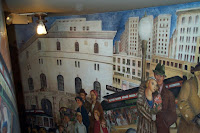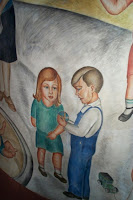In 1929, Lillian Hitchcock-Coit bequeathed $US118,000 to the "beautification" of San Francisco. With this money, Coit Tower was built in 1932 and the murals were commissioned as part of a public works program. The murals depict scenes from California life in 1934 and are frescos - dry pigment brushed on wet plaster. The artists had to work 12-hour days to ensure that their section was completed before the plaster dried.
Compared with our guide for the Mission District, our Coit Tower guide was disappointing - very “school-marmish”. We spent 20-30 minutes sheltering in the main entrance from the rain and wind listening to a spiel on the history of Coit Tower as other people visiting the Tower squeezed by us. Basically the lesson “summarised” the history that was written on a board at the main entrance, which only took 10 minutes to read. I tried to appear interested but it was cold and I was impatient to view the murals - that was the reason I had chosen the mural tour!
When I tried to take one last photo at the end of the tour I was informed that I shouldn't take photos because people might copy the murals. I was so mad - she could have said something at the beginning or during the tour and the sign at the entrance said only camera tripods were prohibited. And there was no way she was going to let me take that last photo!
There were murals on the walls at the base of the tower and a stairwell leading part way up the tower. The following murals are on the walls at the base of the tower.
This photo shows how artists worked around and incorporated into the murals “architectural impediments” such as windows, doors and light switches.
To the left of the Library mural is a mural titled Scientist-Inventor by Mallette (Harold) Dean.
This is such an absorbing mural - there is so much going on. A door in the wall was incorporated as a newsstand.
When it was painted, the mural caused a lot of controversy. Depicted is this photo are left-wing newspapers, a mugging and an accident. Also shown is a fire engine coming from Telegraph Hill, included as a tribute to Lillian Hitchcock-Coit who, as a child, was the mascot of the local fire brigade.
The mural also compresses a lot of prominent sights into the one mural. In fact, the artist has exercised his "artistic license" and shown far more than could be seen in reality from the viewer's vantage point. For example, the City Lights bookshop is not visible from the streets depicted.
Controversy also broke out over the man reading the newspaper. The newspaper he is reading is a financial newspaper but he is standing on a newspaper where the front page story relates to the death of a child.
This mural depicts the four seasons and the agricultural tasks associated with the seasons. The section shown depicts Spring and Summer where the fields are ploughed and the fruit is picked.
The following murals were in the stairwell and on the landings. These murals are not generally open to the public.
This mural is at the bottom of the stairwell and the street scenes are painted on both walls.
Lucien Labaudt was a fashion designer and this is reflected in the detail of the clothes. The mural on the opposite wall includes Lucien Labaudt's store.
This mural is unusual because the children are depicted with adult faces. It is speculated that the artist was inspired by the wooden cut-out figures you see at the seaside where people place their faces in holes on painted bodies to have their photos taken.
This mural was so different from the other murals. It was painted using tempura, a paint made from eggs. This was my favourite mural - simple lines, subtle shades of colour - and I wasn't allowed to photograph it. (I had already taken the photo. As someone famous once said, 'better to ask for forgiveness than permission' - Tony). I was told I could buy a postcard - but not of this one - it wasn't available as a postcard.









No comments:
Post a Comment
Comments for posts older than 14 days will not be immediately displayed. We review these comments before publishing them for public display.